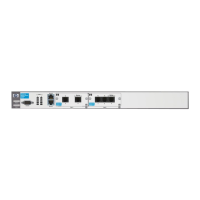B-6
Appendix B: Glossary
B
BACP Bandwidth Allocation Control Protocol. An NCP in the PPP protocol suite that
manages the BAP config option. BACP frames determine which peer will be
favored in the event of a simultaneous submission. Because it is an NCP used
in establishing a PPP connection, BACP frames must be exchanged before any
BAP (LCP) frames are exchanged. For more information about BACP, see RFC
2125 (at http://www.ietf.org/rfc/rfc2125.txt) See also B A P, L C P, a n d N C P.
Bandwidth The amount of data that can flow through a set of transmission lines at a given
time. Bandwidth is usually measured in the number of bits per second.
BAP Bandwidth Allocation Protocol. A link-management protocol that can be used
with MLPPP. BAP configures, maintains, and terminates individual links in a
multilink environment. For more information about BAP, see RFC 2125 (at
http://www.ietf.org/rfc/rfc2125.txt). See also MLPPP.
BECN Backward Explicit Congestion Notification. A device in a Frame Relay net-
work sets the BECN to notify the sending device (DTE) that it cannot receive
data at the rate that the sending device is transmitting it. The sending DTE
(usually a router) can then attempt to slow the traffic by buffering frames. See
also Frame Relay.
BER Bit Error Rate. In any kind of data transmission, the BER is the ratio of bits
that have errors relative to the total number of bits received in a transmission.
The BER is usually expressed as 10 to a negative power. For example, a
transmission might have a BER of 10 to the minus six, meaning that out of
1,000,000 bits transmitted, one bit was in error.
BERT Bit Error Rate Test. A procedure or device that measures the BER for a given
transmission.
BGP Border Gateway Protocol. A protocol for exchanging routing information
between gateway host routers in an autonomous network system. Routers on
the Internet use BGP to route data. BGP routers maintain RIBs and routing
updates, and can also determine the best routes to other devices. For more
information about BGP, see RFC 1771 (at http://www.ietf.org/rfc/rfc1771.txt).
See also Routing Information Base.
B-ISDN Broadband Integrated Services Digital Network. An ISDN standard for trans-
mitting simultaneous voice, video, and data over fiber optic lines.
Blowfish A symmetric encryption algorithm supported by IPSec, the industry standard
for VPNs. Blowfish is many times faster than DES and supports key lengths
up to 448 bits. See also DES, IPSec, and VPN.

